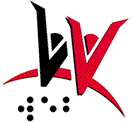



Libraries, schools, colleges, universities, government offices and Internet Cafes all provide access to computer workstations that are used by multiple users each with their own personal set-up preferences or requirements. Depending on the technical support available, users presently make do with the workstation as it is, or spend a great deal of time and effort adjusting the workstation to an approximation of their requirements. Many users with disabilities cannot use these workstations, even when they are "accessible" workstations, because the technology they need is not available or the technical support is not available to set it up the way they need it. In addition, institutions offering and maintaining public workstations are often reluctant to include assistive technologies in the set-up because the technologies conflict with one another or with other software and hardware on the system.
Web-4-All is the first technology in the world that makes it possible for users to carry with them their user interface preferences (including system preferences, browser preferences and assistive technology preferences) and automatically configure public terminals or learning management applications to suit their preferences and access requirements. Web-4-All automatically configures public access terminals according to personal set-up preferences (for the system, the browser and the assistive technology), as saved onto a smart card or other Open Card compliant device. Each Web-4-All user's interface preference is saved as a compressed XML string and uses 2K of storage. It is created using a personal preference wizard program. Once saved to the card, the user can take the card to any public access terminal running Web-4-All software, insert or swipe the card, and cause the system preferences, browser preferences, and assistive technology preferences to be set exactly as they have specified. The user is able to specify the assistive technology they prefer, as well as acceptable alternatives if the preferred technology is not installed on the workstation. If none of the preferred technologies are present, the system will resort to a technology in the same class. When the card is removed, the workstation reverts back to the default configuration and all assistive technologies are shut down to avoid conflict with other users.
WithinWeb-4-All, preferences are grouped into three main branches: display, control and content. "Display" is used to describe how the user interface and the content should be displayed and lists preferences relevant to technologies that offer alternative or enhanced displays such as screen enhancers, screen readers or Braille displays. "Control" specifies how the user interface and content should be controlled and applies to various keyboard, mouse, and alternative input devices and enhancements. "Content" specifies preferred or required content alternatives or augmentations such as captioning and video description. For each class of technology, there is a generic set of preferences that is common across technologies within the class, and a method of specifying technology-specific preference settings that would only apply to a specific product. A user can create different Web-4-All instances for different contexts.
The first public implementation of Web-4-All's user-driven interface preferences is through a Canadian national pilot initiative being undertaken by Industry Canada with support from Bell Canada, the Royal Bank of Canada, and Hitachi Canada. Web-4-All was developed for Industry Canada by the Adaptive Technology Resource Centre (ATRC) of the University of Toronto.
An API has been published by the ATRC to allow assistive technology developers to create Preference Wizard and Configuration Manager plug-ins for their assistive technologies. With a common specification for user preference settings and a tool to implement those specifications on Web-4-All at public workstations, any user should be able to step up to a public workstation and access the assistive technology they are most comfortable with using. The implementation of this common specification will reduce the need for technical support and reduce software conflicts with assistive technologies. Most importantly it will provide a sustainable and realistic method of maintaining accessible public workstations in public institutions and businesses.
We invite all developers of assistive technologies to explore how they might have their assistive technology accessed at public work stations through Web-4-All. A demonstration copy of Web-4-All's Preference Wizard is included on this site for you to view first hand how 3rd. party assistive technologies are referenced by Web-4-All users. Additionally, we encourage you to review the documentation contained on this site, and to contact either Industry Canada or the Adaptive Technology Resource Centre, to learn how your assistive technology and Web-4-All can work together. The complete Web-4-All Preference Wizard Programmers manual has been included on this site. To view this manual click the following link:
Web-4-All
Preference Wizard Programmers Manual
The IMS Global Learning Consortium, an international consortium that develops open technical specifications to support distributed learning, has released a specification that is of great significance to assistive technology developers. The Accessibility for Learner Information Package (ACCLIP) Specification is a schema and model for describing and recording individual preferences regarding the user interface and the selective retrieval of content for computer mediated learning systems. A large portion of the specification is devoted to preferences that are relevant to assistive technologies. This site includes the following specification, supporting documents and an example implementation.
IMS
Accessibility Guidelines (pdf file)
IMS ACCLIP documents (pdf Files)
IMS ACCLIP examples and schemas
References
1.IMS Global Learning Consortium, http://www.imsproject.org.